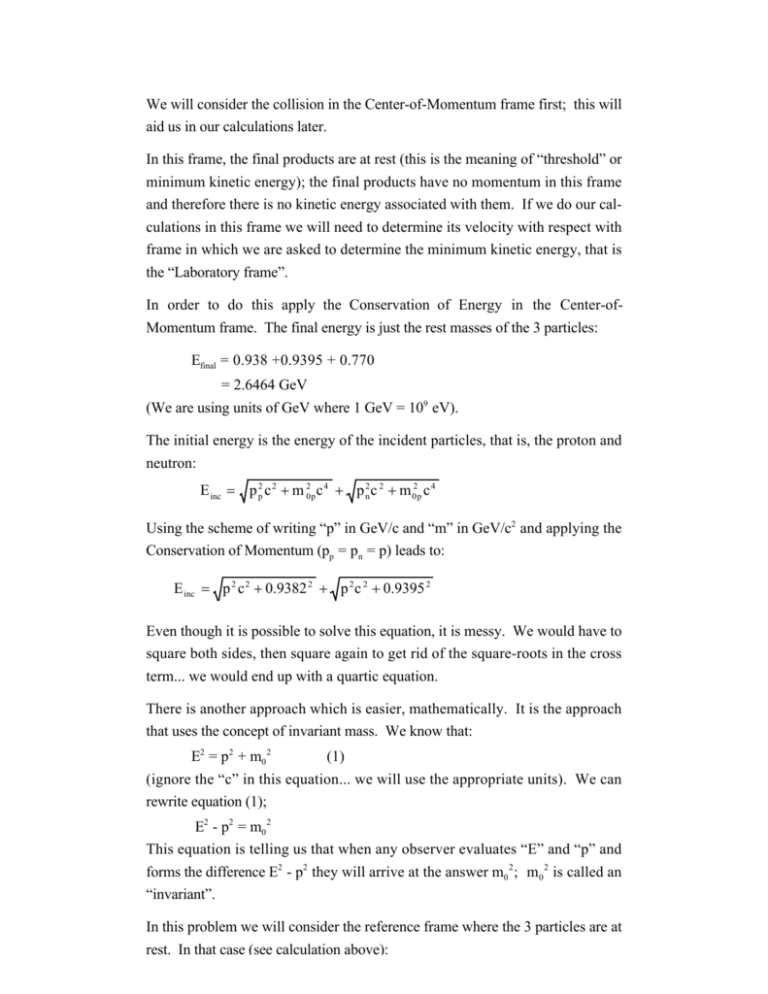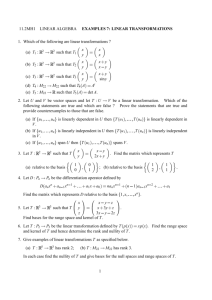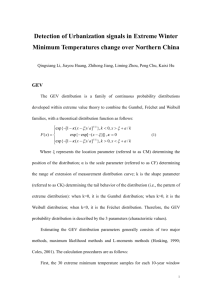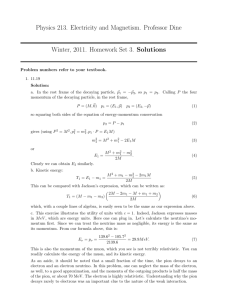We will consider the collision in the Center-of
advertisement

We will consider the collision in the Center-of-Momentum frame first; this will aid us in our calculations later. In this frame, the final products are at rest (this is the meaning of “threshold” or minimum kinetic energy); the final products have no momentum in this frame and therefore there is no kinetic energy associated with them. If we do our calculations in this frame we will need to determine its velocity with respect with frame in which we are asked to determine the minimum kinetic energy, that is the “Laboratory frame”. In order to do this apply the Conservation of Energy in the Center-ofMomentum frame. The final energy is just the rest masses of the 3 particles: Efinal = 0.938 +0.9395 + 0.770 = 2.6464 GeV (We are using units of GeV where 1 GeV = 109 eV). The initial energy is the energy of the incident particles, that is, the proton and neutron: E inc = p 2p c 2 + m 20 p c 4 + p 2n c 2 + m 02p c 4 Using the scheme of writing “p” in GeV/c and “m” in GeV/c2 and applying the Conservation of Momentum (pp = pn = p) leads to: E inc = p 2 c 2 + 0.9382 2 + p 2 c 2 + 0.9395 2 Even though it is possible to solve this equation, it is messy. We would have to square both sides, then square again to get rid of the square-roots in the cross term... we would end up with a quartic equation. There is another approach which is easier, mathematically. It is the approach that uses the concept of invariant mass. We know that: E2 = p2 + m0 2 (1) (ignore the “c” in this equation... we will use the appropriate units). We can rewrite equation (1); E2 - p2 = m0 2 This equation is telling us that when any observer evaluates “E” and “p” and forms the difference E2 - p2 they will arrive at the answer m0 2 ; m0 2 is called an “invariant”. In this problem we will consider the reference frame where the 3 particles are at rest. In that case (see calculation above): m0 = 2.6464 GeV/c2 We can now go to the “Laboratory” frame and write: E2 system - p2 system = (2.6464)2 But: Esystem = En + m0p where En is the total energy of the incident neutron (it is the variable we have to determine). psystem is the momentum of the incident neutron, pn . Therefore: (En + m0p )2 - p2 n = (2.6464)2 Expanding this equation results in: En 2 + 2 En m0p + m0p 2 - p2 n = (2.6464)2 But we know that En 2 - p2 n = m0n 2 (it is the invariant for the neutron!). Putting this into the equation leads to: m0n 2 + 2 En m0p + m0p 2 = (2.6464)2 Rearranging terms: (2.6464) 2 − m20p −m 20n En = 2m 0p 7.001− 0.880 − 0.883 1.876 = 2.792 GeV So, the neutron’s kinetic is: = K = E - E0 = 2.792 - 0.939 = 1.793 GeV









